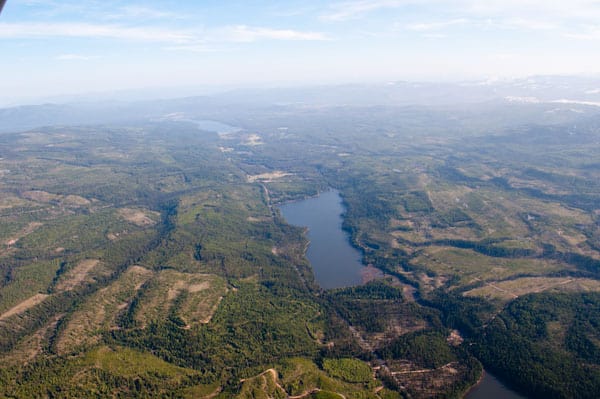Thanks to JZ for this contribution.
From the Helena here: LEWISTON, Idaho (AP) — N. Idaho logging project faces possible lawsuit
“Two environmental groups say they will file a lawsuit against the U.S. Forest Service concerning a planned logging project in the Nez Perce-Clearwater National Forests.
Friends of the Clearwater in Moscow, Idaho, and the Alliance of the Wild Rockies in Helena have filed a 60-day notice as required under federal law.”
“… the groups contend the 2,500-acre Little Slate Project in northern Idaho will harm protected species, including Canada lynx, bull trout, steelhead and spring and summer chinook.”
“The project involves a mix of logging and restoration, with the goal of treating lodgepole pine stands harmed by beetle infestations.”
A copy of the appeal response for the project can be found here.
The project file here.
From the ROD on the vegetation treatments:
Vegetation Treatments
Alternative B2 will conduct timber harvest and fuel reduction treatments on 2,598 acres to alter species composition and structure.
Regeneration harvest will occur on 2,188 acres as described below.
• 1,211 acres will be clearcut with reserves. Most of the existing mature stand will be removed to
produce a site with high sun exposure that will provide optimum growing conditions for the new
stand. This prescription will be implemented in lodgepole pine dominant stands with little
regeneration and few healthy trees in the overstory. Approximately 5 to 10% of the existing
canopy will be retained in all harvest units to serve as shelter and some cases, serve as a seed
source. Following site preparation, the units will be planted with western larch and ponderosa
pine. Some areas will be allowed to regenerate naturally.
• 600 acres will be seed tree cut with reserves. This prescription will be implemented in areas
dominated by lodgepole pine where healthier, vigorous trees of desirable species (western larch,
ponderosa pine, Douglas fir) are present in the overstory to provide a source of seed for natural
regeneration. Eight to ten trees per acre will be left widely scattered on the sites following
harvest to provide seeds for natural regeneration and serve as shelter. Seed tree retention is based
on desired species, wind firmness, and seed-producing capacity and is considered in the count of
green tree replacements for snags. Ten to 20 percent of the canopy should be present following
treatment. Following site preparation, the units will be planted with western larch and ponderosa
pine or allowed to regenerate naturally.
• 377 acres will be shelterwood cut. This prescription will be implemented in areas dominated by
lodgepole pine, with areas which contain higher concentrations of other species including western
larch, ponderosa pine, Douglas-fir, grand fir and Engelmann spruce. Approximately 20 to 40%
(15 to 40 trees per acre) of the overstory tree canopy will be retained to provide shade, structural
diversity and other resource benefits. Retained trees consist of healthy, vigorous medium to large
diameter western larch, ponderosa pine and Douglas fir. These trees will be included in the count
for green tree replacements for snags. Following site preparation, the units will be planted with
western larch and ponderosa pine or allowed to regenerate naturally.
Commercial thinning will be completed on 410 acres to increase growth, vigor, and resistance to
damage from fire, insects and diseases. This prescription will be implemented in areas that are
predominantly mixed conifer. Intermediate suppressed trees will be harvested and about 40 to 100
overstory trees per acre of healthy dominant and co-dominant trees will be retained, leaving 40-70%
canopy coverage. Seral species such as ponderosa pine and western larch will be favored for retention,but healthy, larger Douglas-fir, Engelmann spruce and grand fir are viable leave trees. In areas where nodesirable leave trees exist, openings up to two acres in size may be created.
Snag, Downed Wood and Standing Live Tree Retention. All regeneration and commercial thinning
treatments will retain snags, green trees and downed wood consistent with Region 1 snag and green tree
retention guidelines as revised by the Nez Perce Forest for each cover type (See FEIS, Appendix C).
Green reserve trees will be retained, where possible, around snags to protect them from logging or
burning and reduce the likelihood of being felled as a hazard tree. The larger trees in a unit will be
retained, with a preference of western larch, ponderosa pine, and Douglas-fir where they occur. Reserve
trees may be lodgepole pine if they are free of mistletoe and mountain pine beetle. Trees with dwarf
mistletoe infections (lodgepole pine, western larch, and Douglas-fir) should not be retained if possible.
After treatment, all units will retain 7-14 tons per acre of downed woody material 3 inches diameter or greater in grand fir habitat types and 12-23 tons per acre in subalpine fir habitat types. (Graham et al.1994).
Note from Sharon: Photos of the units with some reasonable before and after photos of similar treatments would be helpful in discussions and with the public. A picture is worth 1000 words. Are there any out there? If so, please send to [email protected].
 Above are the details of the disputed project.
Above are the details of the disputed project.

